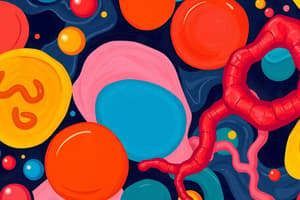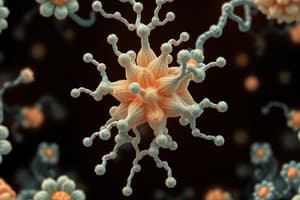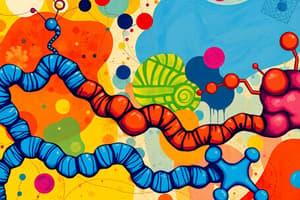Podcast
Questions and Answers
Match the following biomolecules with their properties:
Match the following biomolecules with their properties:
Phospholipids = Non-polar barrier to water Waxes = Long chain fatty acids Steroids = Non-polar hormones Proteins = Polar, non-polar, solubility
Match the following biomolecules with their primary function:
Match the following biomolecules with their primary function:
Phospholipids = Form membrane structure Waxes = Provide barrier to water Steroids = Act as hormones Proteins = Catalyze reactions
Match the following protein structures with their examples:
Match the following protein structures with their examples:
Linear Polypeptides = Insulin, Keratin Globular Proteins = Myoglobin, Spider silk
Match the following amino acid functional groups with their roles/functions:
Match the following amino acid functional groups with their roles/functions:
Match the following components with their description:
Match the following components with their description:
Match the following with their functional groups:
Match the following with their functional groups:
Match the following properties with their characteristics:
Match the following properties with their characteristics:
Match the following types with their descriptions:
Match the following types with their descriptions:
Match the following roles/functions with their descriptions:
Match the following roles/functions with their descriptions:
Match the macromolecule with its subunit:
Match the macromolecule with its subunit:
Match the macromolecule with its primary role/function:
Match the macromolecule with its primary role/function:
Match the macromolecule with its primary linkage between molecules:
Match the macromolecule with its primary linkage between molecules:
Match the macromolecule with its main functional group:
Match the macromolecule with its main functional group:
Match the macromolecule with its key property:
Match the macromolecule with its key property:
Match the macromolecule with the type of reaction that forms its polymer:
Match the macromolecule with the type of reaction that forms its polymer:
Flashcards are hidden until you start studying
Study Notes
Biomolecules and Their Properties
- Biomolecules are categorized into four main types: carbohydrates, proteins, lipids, and nucleic acids, each with unique properties.
- Carbohydrates primarily serve as energy sources and structural components in cells.
- Proteins function as enzymes, hormones, and structural support within organisms, determined by their amino acid sequences and structures.
- Lipids are essential for energy storage, cell membrane formation, and signaling molecules.
- Nucleic acids carry genetic information; DNA stores it, while RNA plays a role in protein synthesis.
Protein Structures and Examples
- Primary structure refers to the sequence of amino acids in a polypeptide chain.
- Secondary structure includes alpha helices and beta sheets formed by hydrogen bonding between backbone atoms.
- Tertiary structure represents the overall 3D shape of a protein, determined by interactions between R-groups of amino acids.
- Quaternary structure consists of multiple polypeptide chains assembling into a functional protein complex.
Amino Acid Functional Groups
- Amino groups (-NH2) play a crucial role in forming peptide bonds and determining amino acid properties.
- Carboxyl groups (-COOH) contribute to the acidity and reactivity of amino acids.
- Side chains (R-groups) determine the unique characteristics and functions of each amino acid, including polarity and charge.
Components and Their Descriptions
- Enzymes are proteins that catalyze biochemical reactions, lowering the activation energy required.
- Substrates are the reactants that enzymes act upon.
- Cofactors are non-protein molecules that assist enzymes in their function.
Functional Groups and Their Roles
- Hydroxyl groups (-OH) increase solubility in water and are involved in dehydration and hydrolysis reactions.
- Carbonyl groups (C=O) are found in sugars and affect molecular reactivity.
- Carboxyl groups (-COOH) illustrate acidic properties in biomolecules.
Properties of Biomolecules
- Solubility varies with chemical structure; polar molecules dissolve well in water, while non-polar molecules do not.
- Stability impacts the longevity and functionality of biomolecules, influenced by their molecular composition.
- Reactivity determines how biomolecules interact with other molecules, critical for metabolic processes.
Types and Descriptions
- Macromolecules are large complexes made from smaller subunits known as monomers.
- Polymers are formed through dehydration synthesis, linking monomers by covalent bonds.
- Monosaccharides, amino acids, nucleotides, and fatty acids are the fundamental building blocks of carbohydrates, proteins, nucleic acids, and lipids, respectively.
Roles/Functions and Descriptions
- Enzymes speed up chemical reactions, making them essential for metabolic pathways.
- Structural proteins provide support and shape to cells and tissues.
- Signaling molecules facilitate communication within and between cells.
Macromolecules and Their Subunits
- Carbohydrates are polysaccharides made from monosaccharide units.
- Proteins are polymers made from amino acid subunits.
- Nucleic acids, like DNA and RNA, are long chains of nucleotides.
Macromolecule Functions
- Carbohydrates primarily serve as energy sources.
- Proteins are critical for biological functions and structural integrity.
- Nucleic acids carry genetic blueprints for heredity and protein synthesis.
Macromolecule Linkages
- Glycosidic bonds link monosaccharides to form carbohydrates.
- Peptide bonds connect amino acids, forming proteins.
- Phosphodiester bonds link nucleotides in nucleic acids.
Main Functional Groups of Macromolecules
- Carbohydrates contain hydroxyl (-OH) and carbonyl (C=O) groups.
- Proteins contain amino (-NH2) and carboxyl (-COOH) groups.
- Nucleic acids feature phosphate (PO4) groups.
Key Properties of Macromolecules
- Carbohydrates provide quick energy and are readily digestible.
- Proteins exhibit diverse functions based on their structure.
- Lipids serve as energy reserves and waterproof barriers.
Polymer Formation Reactions
- Dehydration synthesis creates polymers from monomers by releasing water molecules.
- Hydrolysis cleaves polymers into monomers, requiring water molecules.
Studying That Suits You
Use AI to generate personalized quizzes and flashcards to suit your learning preferences.




